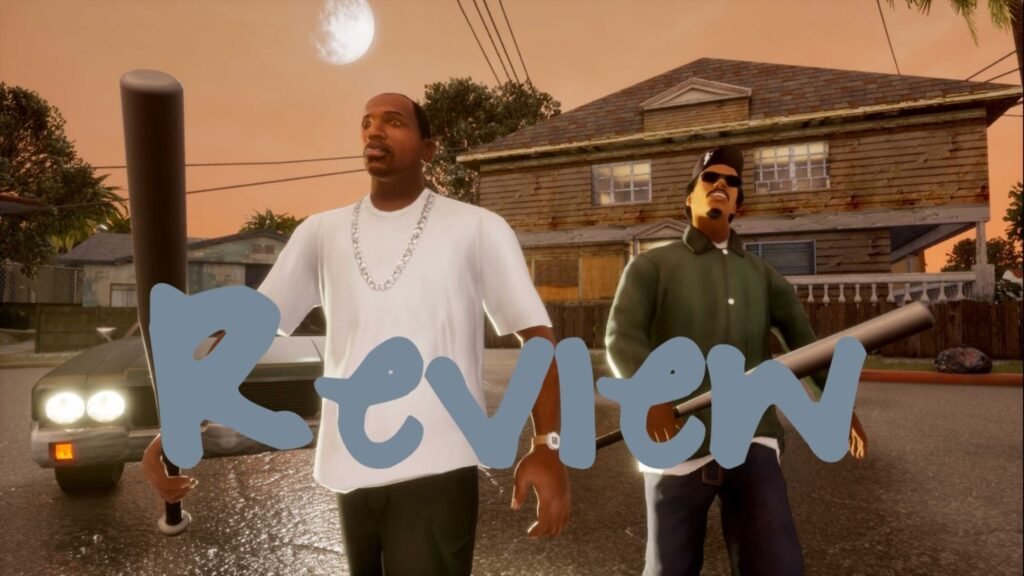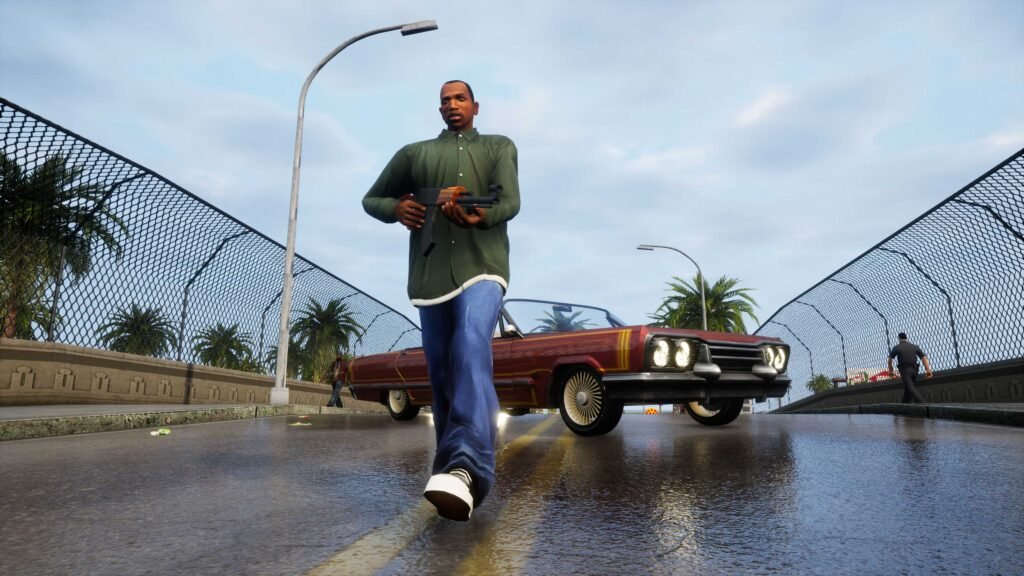Has any game released in the last 20 years been more influential than Grand Theft Auto III? From establishing the open-world sandbox formula to reshaping video games into a more mature medium, GTA III‘s legacy still looms large over almost every aspect of the art form. If any game deserved a definitive edition that allowed fans to relive that revolutionary moment without being distracted by outdated graphics, it’s this one. And yet, Rockstar Games—the creator of the GTA series—has decided to honor this modern gaming monolith and its two equally acclaimed PS2-era sequels, Vice City and San Andreas, by releasing a collection of re-releases that cuts more corners than a Diablo stallion in a Liberty City street race.
At best, this trilogy is half-baked and ill-conceived; at worst, it’s downright broken. If this “Definitive Edition” is any indication, I’m left wondering if Rockstar truly reveres its own games as much as the rest of us do.
There are some positives, of course, but almost every welcome addition comes at the cost of some frustrating compromise. Weapon switching has been improved across the board with the addition of a weapon wheel, but auto-targeting feels far snappier in San Andreas than it does in GTA III and Vice City. While you can now circle-strafe while locked onto an enemy with lighter weapons, heavier ones, like machine guns, still root you to the spot and force you into a clunky, manually aimed first-person perspective.
Auto-targeting in GTA III and Vice City proves particularly sluggish, especially in close quarters when you’re surrounded by a group of enemies—an all-too-common scenario, given that enemy AI lacks cover usage and tends to rush you. Similarly, while it’s nice to be able to place waypoint markers on the map, the new system has its drawbacks. You can’t override waypoints created automatically during missions, and the pathfinding is often so confused that it looks more like a hastily scribbled signature than a coherent route.
A mid-mission checkpointing system has been implemented to good effect in San Andreas, allowing you to restart with full health and weapons, skipping the early setup phase of certain missions. However, in GTA III and Vice City, selecting the restart checkpoint option simply boots you back to the very beginning of the mission, no matter how far you’ve progressed. This can result in tedious repetition, particularly in some of the more challenging late-game missions. It’s odd that San Andreas allows you to cut to the chase, while the other two games force you to repeat the same steps over and over.
Then there’s the issue with the new character designs. They’ve certainly been controversial, and while I wouldn’t say they look good, I personally didn’t mind them. Sure, they resemble down-and-out Disney Infinity dolls, but the only time I found them truly distracting was during cutscenes, where characters would hold objects in mid-air where their blocky, fingerless fists used to be.
This brings me to the overhauled graphics in the Definitive Edition. They’re like a shiny new sheet of high-resolution stickers hastily slapped on top of an aging LEGO set. While they look cleaner on the surface, there’s no real consistency in how they’ve been applied, and everything still feels somewhat chunky underneath. It’s clear that much of the work in porting these games to Unreal Engine 4 was automated, and it shows in game worlds that are sharper than you remember, yet noticeably sloppier in terms of artistic direction, lacking the atmosphere they once had.
The new lighting system also has mixed results. Neon lights pop, and reflections on cars and puddles are appealing, but the overly intense shadows can plunge characters into darkness, no matter how much you tweak the brightness and contrast settings. Despite this, squinting to make out detail in dark areas is still less painful than the truly torturous rain effect, which made me feel like I was being waterboarded with a can of silly string.
An improved draw distance, which was likely intended to make each environment feel bigger, has had the opposite effect. This is especially apparent in San Andreas, where the removal of the Los Angeles-inspired smog haze—once used to hide the PS2’s technical limitations—now lets you see the San Fierro skyline looming in the near distance when standing in Flint County. This completely shatters the illusion of scale that the map once created.
The improved draw distance may also be contributing to the collection’s frequent performance issues, particularly the wavering framerate on PS5. Whether you choose fidelity or performance mode, the game suffers from frequent stuttering. Why players are even forced to make this choice on a modern console—especially for games that are each old enough to vote—remains a mystery.
And then there are the bugs, which seem to be lurking around every corner like a gang of game-breaking thugs, ready to ambush you at any moment. Whether it’s character models clipping through the environment, physics glitches, or mission scripts failing to trigger properly, these bugs detract from the experience in frustrating ways. In fact, the constant technical hiccups and unfinished-feeling nature of this remaster leave you wondering if Rockstar truly respected the games they’ve re-released.
Ultimately, Grand Theft Auto: The Trilogy – The Definitive Edition does not live up to the promise of its name. What could have been a flawless way to relive the revolutionary GTA era instead feels like a rushed attempt to capitalize on nostalgia without properly honoring what made these games so iconic. While the improved controls, enhanced graphics, and new features show promise, they are marred by a series of technical issues, design missteps, and disappointing compromises. It’s a trilogy that deserved better, and sadly, it doesn’t live up to its own legacy.
Hard crashes, frozen cutscenes, NPCs running in circles, missing mission objectives, disappearing bridges, invisible obstacles, building exteriors failing to load, and even pedestrians trapped in trees—these are just a few of the numerous bugs I encountered across all three games in GTA Trilogy. I also experienced some odd texture glitches, like my character, CJ, permanently resembling Watchmen‘s Rorschach. And don’t get me started on how fragile the vehicles are now. I can only assume the developer is scrambling to release bug-fixing patches, but it feels a bit like locking the stable door after the horse has bolted—or closing the garage door after the car has glitched inside the house and exploded.
Still, it’s a testament to how brilliant these games remain that I found myself smiling during my replays despite all the issues. There’s no denying that the mission design has aged, particularly in GTA III, and outdated limitations like the lack of swimming in both GTA III and Vice City can be tough to overlook—unless, of course, you happen to just magically bounce off the water.
But beyond the bugs and flaws, these games are still video game playgrounds packed with personality and invention, and their incredible soundtracks remain as memorable as ever, despite a few notable licensed omissions. I genuinely enjoyed revisiting the hilarious radio commercials and pedestrian banter. “I wanna raise a family!” “That’s just it, Tim! They’ve got your family!” It was also fascinating to play through all three games back-to-back and see the rapid evolution of a series and a genre that would soon dominate the gaming world.
GTA III established the blueprint, Vice City refined it while adding weaponized ’80s nostalgia, and San Andreas expanded it in every direction, arguably perfecting the formula given the technology of the time. That’s what makes these re-releases such a bitter pill to swallow. While these games may have aged too much to attract new players, they’re still a fun revisit for long-time fans—but this is far from the ideal way to experience them.
It’s like if Martin Scorsese announced a new director’s cut of Goodfellas, but then handed the editing duties over to McG. Sure, you’re still getting three iconic GTA games, and they’re still playable, but they’re not delivered with the meticulous craftsmanship we’ve come to expect from Rockstar.
There’s no doubt that the three games in this GTA trilogy are all-time classics, but unfortunately, they’ve been remastered with a heavy hand instead of the loving touch they deserve. New features are sparse and only partially implemented, the visuals are inconsistent, performance is shaky at best, some content is missing, and bugs are rampant. In its current state, this collection of classic GTA games is far from being definitive. It’s defective, disappointing, and, frankly, disrespectful to both the legacy of the games themselves and their legions of loyal fans.

